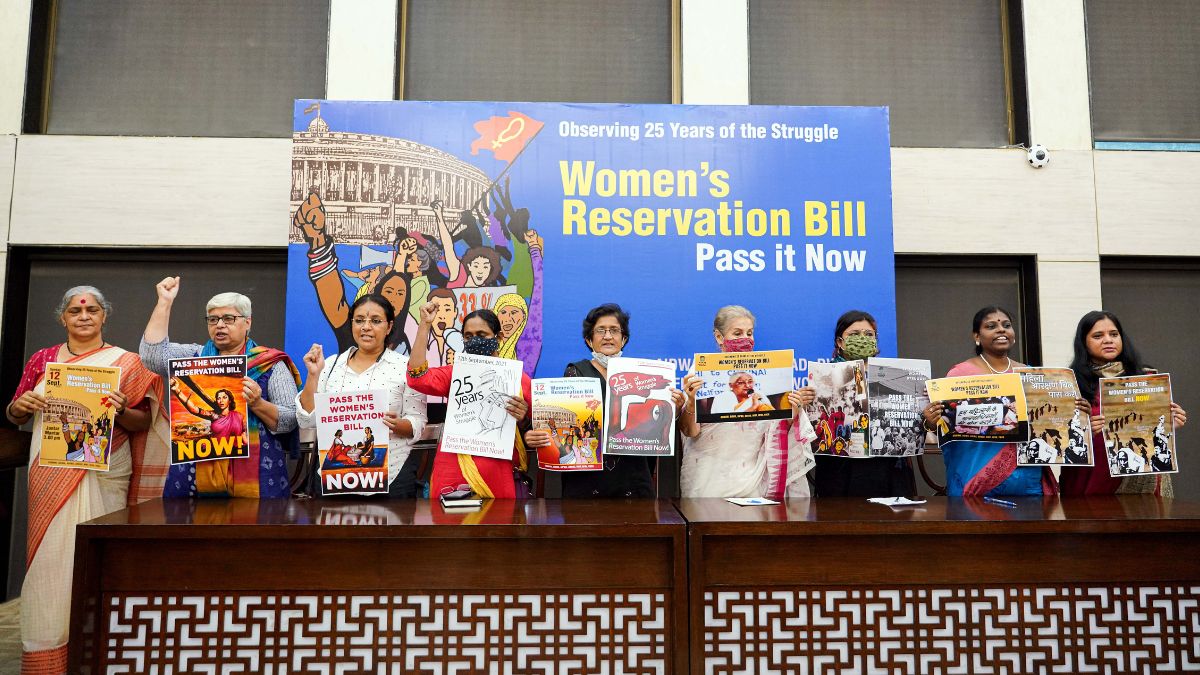- By Vivek Raj
- Tue, 19 Sep 2023 12:31 AM (IST)
- Source:JND
The five-day special Parliament session commenced on Monday, September 18, with numerous political parties demanding the urgent passage of the long-pending women's reservation bill during this session. In response, the Centre affirmed that an “appropriate decision will be taken at an appropriate time”.
The Women's Reservation Bill, which has been on hold for nearly 27 years, was the focal point of discussion at an all-party meeting convened by the BJP on the eve of the special session. Several political leaders have been advocating for its introduction and passage with consensus.
Background of Women's Reservation in Indian Politics
The pursuit of reservation for women in Indian politics traces its roots back to the Indian National Movement. In 1931, leaders Begum Shah Nawaz and Sarojini Naidu submitted an official memorandum to the British prime minister, jointly addressing the status of women in the new Constitution. “To seek any form of preferential treatment would be to violate the integrity of the universal demand of Indian women for absolute equality of political status,” the memorandum read, according to a peer-reviewed journal ‘The Indian Journal of Gender Studies’.
In 1988, the National Perspective Plan for Women recommended the provision of reservation for women at various political levels, ranging from Panchayati Raj institutions to Parliament.
Reservation In Panchayati Raj Institutions
These recommendations culminated in the historic enactment of the 73rd and 74th amendments to the Constitution, mandating all state governments to reserve one-third of seats for women in Panchayati Raj institutions and one-third of the chairperson positions at all Panchayati Raj levels, as well as in urban local bodies. Within these reserved seats, one-third are further designated for Scheduled Caste/Scheduled Tribe women. The amendments were passed by Parliament in December, 1992.
Several Indian states, including Maharashtra, Andhra Pradesh, Bihar, Chhattisgarh, Jharkhand, and Kerala, have implemented legal provisions to ensure 50% reservation for women in local bodies.
The Women's Reservation Bill (WRB)
The Women's Reservation Bill seeks to reserve 33 per cent of seats in the Lok Sabha and state Legislative Assemblies for women.
Reserved seats may be rotated among different constituencies within the state or union territory.
Reservations for women would cease to exist 15 years after the enactment of this Amendment Act.
Need For WRB
India's ranking in the Global Gender Gap Report 2022, particularly in the Political Empowerment dimension (percentage of women in Parliament and ministerial positions), stands at 48th out of 146 countries. However, India's score in this category remains relatively low at 0.267. In comparison, top-ranking countries such as Iceland (ranked 1) and Bangladesh (ranked 9) score significantly higher.
While women representatives from Panchayati Raj have made commendable contributions to rural development, they face numerous challenges when attempting to navigate the broader political landscape in India.
History And Timeline Of Bill
1996: The WRB was first introduced in 1996 and was referred to a Joint Parliamentary Committee (chaired by Geeta Mukherjee). However, the Bill lapsed with the dissolution of the Lok Sabha.
1998: The Bill was reintroduced but did not garner support and lapsed.
1999: Reintroduced by the NDA government in the 13th Lok Sabha, it was presented twice again in 2003.
2004: The UPA government included the WRB in its Common Minimum Programme and ultimately tabled it in the Rajya Sabha to prevent it from lapsing again in 2008.
2010: The bill got passed in the Rajya Sabha but lapsed in the Lok Sabha. Since then, the demand for the Women’s Representation Bill has continued.
Why WRB Still Awaits Legislature’s Nod ?
Heated Debates and Sexist Taunts: The WRB has been the subject of impassioned debates and sexist remarks.
Quota within Quota: The 1996 committee recommended reservation for OBC women within the 1/3rd reservation for women, but this demand has not been incorporated, leading to objections.
Lack of Political Will: Few political parties have reserved seats for women in election candidatures. Only Odisha’s Biju Janata Dal (BJD) and West Bengal’s Trinamool Congress (TMC) have reserved seats for women in election candidatures.
Diversion of Focus: Critics argue that the WRB diverts attention from broader electoral reform issues such as the criminalization of politics and inner-party democracy.
Women in Parliament: India and Worldwide
Only 14 per cent of MPs in the 17th Lok Sabha are women (78 in total), with women constituting approximately 11 per cent of the Rajya Sabha.
Although the number of women MPs has significantly increased since the 1st Lok Sabha (5 per cent), it remains substantially lower than many other countries. According to PRS data, countries like Rwanda (61 per cent), South Africa (43 per cent), and even Bangladesh (21 per cent) have surpassed India in women's representation.
The Inter-Parliamentary Union's latest report ranks India 144th out of 193 countries in terms of women's representation in Parliament. The renewed call for the Women's Reservation Bill reflects a critical effort to enhance gender equity and political empowerment in India.

